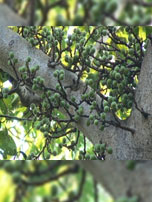SHAHEED KARTAR SINGH SARABHA AYURVEDIC MEDICAL COLLEGE & HOSPITAL
Affiliated to Guru Ravidas Ayurved University, Hoshiarpur Punjab
Affiliated to Guru Ravidas Ayurved University, Hoshiarpur Punjab

Botanical Name : Ficus racemosa Linn.
Family : Moraceae
Introduction :
Udumbara is one of the few extensively described plants in the vedic literature. Atharva veda quotes that Udumbara Mani dhãrana enhances the strength of human body.
Scientific classification: Figs constitute the genus Ficus, of the family Moraceae. The common commercial fig is classified as Ficus carica, Ficus racemosa, the sycamore fig as ficus sycomorus, and the pipal, or sacred fig, as Ficus religiosa. The common rubber plant is classified as Ficus elastica, and the banyan tree, or Indian fig, as Ficus bengalensis. The two figs native to the subtropical United States are classified as Ficus aurea and Ficus citrifolia.
Names in different Indian languages :
English: Cluster Fig
Hindi: Gular, umar
Kannada: Atti
Malayalam: Atti
Sanskrit: Udumbarah, sadaphalah
Tamil: Attiu
Telugu: Udambarah, paidi
Unani: Anjir-e-Aadam, Anjir-e-Ahmak, Gular
Synonyms :
Sadaaphala, Hema-daudhaka, Jantuphala, Yagyaanga.
Ficus glomerata Roxb.
Classification according to Charaka, Susrutha & Vagbhata :
Charaka
Mütrasangrahaniya, Kasãya skañdha
Susrutha
Nyagrodhadi gana
Vagbhata
Nyagrodhãdi
Varieties & adulterants – (CV – controversy, AD – adulterants) :
1. Udumbara (F. glomerata)
2. Kãhodumbara/Kakodumbara (F. hispida)
3. Nadyodumbara-F. carica [CV]
Ficus krishnae
Ficus virens
Morphology :
A moderate to large deciduous tree, 10 – 12 m. high.
Bark— smooth, reddish-grey.
Leaves— 3-veined, elliptic, ovate or ovate-lanceolate.
Fruits— borne in large clusters on short leaflet branches derived from the trunk and main branches, subglobose or pyriform, 2.5-5.5 cm diameter red when ripe.
Habitat & Distribution :
Almost throughout India.
Chemical composition :
Gluacol,beta-sitosterol, lupeol acetate, friedelin, phytosterols
Tree contains tannins,wax, rubber and ash which contains silica and phosphoric acid.
Leaves & Fruits— gluacol
Fruits— beta Sitosterol, lupeol acetate, friedelin, phytosterols etc.
Bark—beta sitosterol, ceryl behenate, lupeol, friedelin
Properties :
Rasa Kasäya
Guna Guru, Rüksa
Virya sita
Vipãka Katu
Karma : Pitta-kaphahara, Vrana ropana-swedhana, varnya
astringent, carminative, digestive, stomachic
Indications— svitra, Vãtarakta, Vrana, Rakta vikãra, Murchã, Kandabhagna, Dãha, Yoniroga, Raktapitta, Atisära etc
menorrhagia, leucorrhoea, urinary disorders, skin diseases, swellings, boils, haemorrhages, diarrhoea, dyspepsia, dysentery
Parts used :
Bark, fruit, latex and roots.
Dosage :
powder 5-10 g. decoction 50 -100 ml., latex 5-10 drops
External uses :
Reduces oedema – its latex is used as liniment for swelling and pain. For wound healing its raw stem is used in the form of liniment. A thick decoction of bark is applied locally for stomatitis. Topical use reduces burning sensation. Extract of bark is used as mouthwash and gargling in pharingitis and stomatitis udumbarsar.
Internal uses :
Digestive system : Agnisadak and astringent. Ripe fruits are anthelmintic. Because of the astringent property, decoction of bark is given in dysentery and diarrhoea associated with bleeding per rectum and spruce raw fruits are given as cooked vegetables. The latex with sugar is used for infantile diarrhea and teething problems. In case of bhasmak roga. the powder or bark is given with human milk and water. Fruit juice is given for hiccups.
Circulatory system : Udumbar is raktagarni, so bark and fruits are used in haemorrhagic disorders. Hall a leaf is given with betel leaves for treating jaundice.
Reproductive system : Decoction of the bark is useful in menorrhagia and leucorrhoea. In Uttar basti a decoction is given. It is also used for fetal nutrition. Its latex along with sugar or sugar preparation known as batasa is recommended in sperm debility. Regular consumption of ripe fruits causes sterility.
Urinary system : It is an antidiuretic. In prameha . the decoction of bark and ripe fruits is given. In diabetes, juice of fruits or roots is given.
Temperature : Ripe fruits being refrigerant, are given for treating fever.
Parts used : Bark, fruit, latex. It is believed that water is found near the udumbar tree which may mean that udumbar free grows near a water source. Ripe fruits are very good in healing, burning sensation and wounds. The burning sensation on the fingers of Narasimha when he tore open Hiranyakashyapu’s stomach was ameliorated by the fruits of udumbara.
It is believed that water is found near the udumbar tree which may mean that udumbar tree grows near a water source. Ripe fruits are very good in healing, burning sensation and wounds. The burning sensation on the fingers of Narasimha when he tore open Hiranyakashyapu’s stomach was ameliorated by the fruits of udumbara.
Important Yogas or Formations :
udumbarãdi taila, Pañcavalkaja Kvãtha
Important research work going on :
(1) diabetic rabbits
(2) hypotensive and vasodilator effect
(3) antiprotozoal activity
(4) cardiac-depressive effect
Therapeutic Uses :
(1) Garbhapata— Udumbara fruit decoction is mixed with säli rice powder and sugar is administered with honey (R.M.).
(2) Hikkä— Ash of Udumbara bark is mixed with honey and ghee and given (S.S.Ut. 50).
(3) Prameha pitikã— Udumbaraksira is applied external, (G.N.).
(4) Pumsavana— Vandãka growing on Udumbara tree is given with goats milk — (V. D.).
